Evidence-Based Therapeutic Interventions for Pressure Ulcers
VerifiedAdded on 2022/11/25
|17
|4112
|148
AI Summary
This paper explores evidence-based therapeutic interventions for pressure ulcers, including repositioning, mobilization therapies, and nutritional aspects. It also discusses the importance of risk assessment and the use of static mattresses and overlays. Recommendations for practice change and research are provided.
Contribute Materials
Your contribution can guide someone’s learning journey. Share your
documents today.
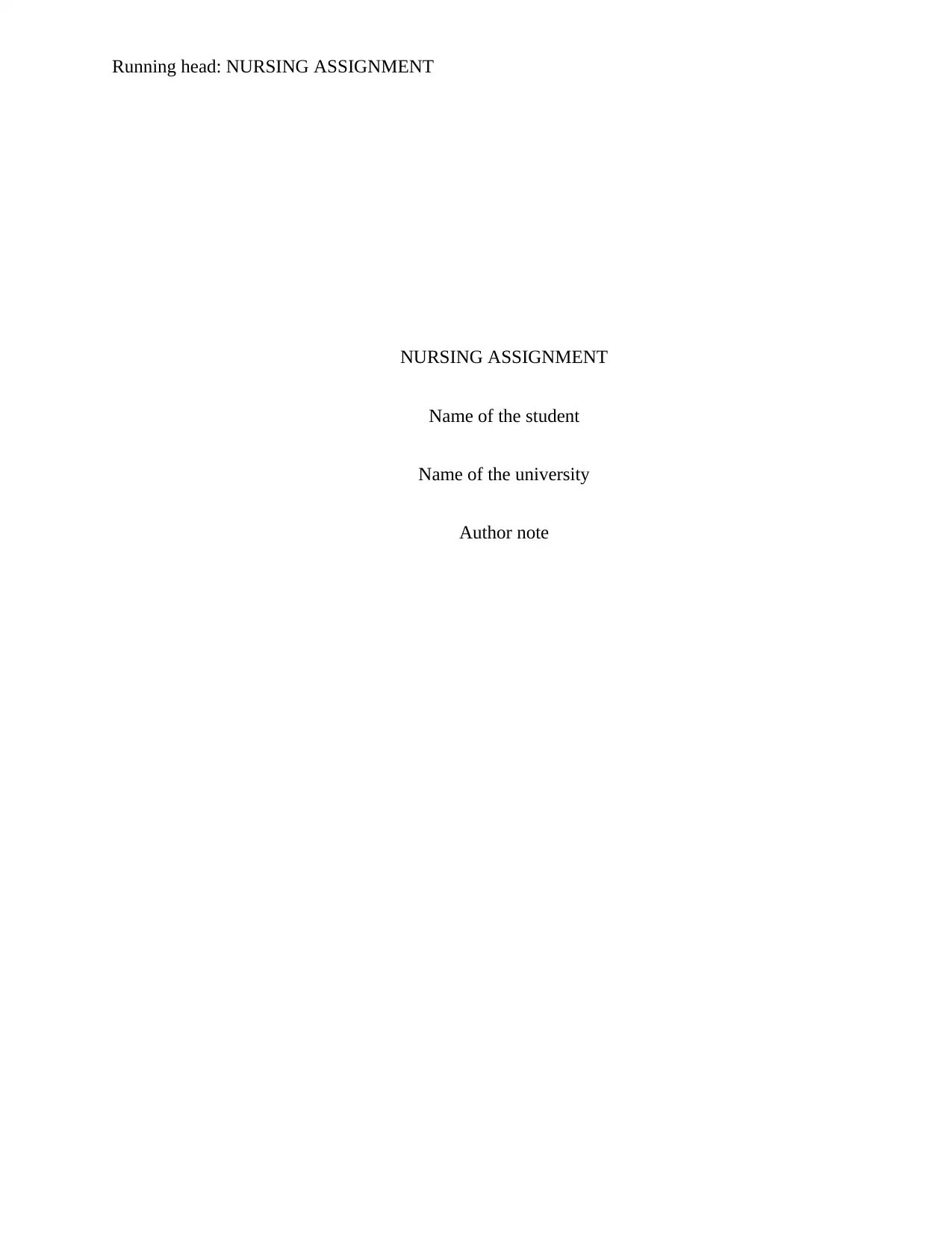
Running head: NURSING ASSIGNMENT
NURSING ASSIGNMENT
Name of the student
Name of the university
Author note
NURSING ASSIGNMENT
Name of the student
Name of the university
Author note
Secure Best Marks with AI Grader
Need help grading? Try our AI Grader for instant feedback on your assignments.
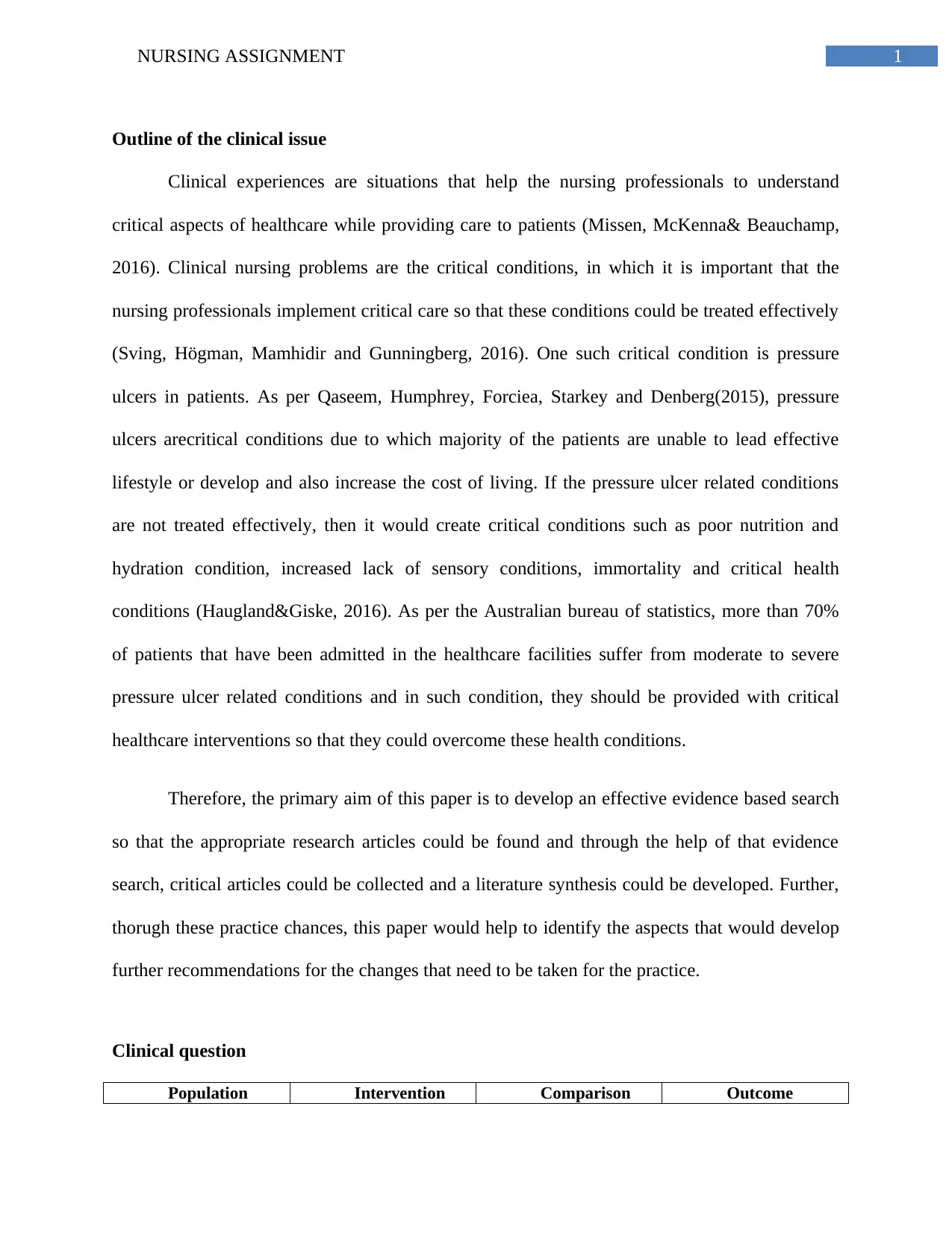
1NURSING ASSIGNMENT
Outline of the clinical issue
Clinical experiences are situations that help the nursing professionals to understand
critical aspects of healthcare while providing care to patients (Missen, McKenna& Beauchamp,
2016). Clinical nursing problems are the critical conditions, in which it is important that the
nursing professionals implement critical care so that these conditions could be treated effectively
(Sving, Högman, Mamhidir and Gunningberg, 2016). One such critical condition is pressure
ulcers in patients. As per Qaseem, Humphrey, Forciea, Starkey and Denberg(2015), pressure
ulcers arecritical conditions due to which majority of the patients are unable to lead effective
lifestyle or develop and also increase the cost of living. If the pressure ulcer related conditions
are not treated effectively, then it would create critical conditions such as poor nutrition and
hydration condition, increased lack of sensory conditions, immortality and critical health
conditions (Haugland&Giske, 2016). As per the Australian bureau of statistics, more than 70%
of patients that have been admitted in the healthcare facilities suffer from moderate to severe
pressure ulcer related conditions and in such condition, they should be provided with critical
healthcare interventions so that they could overcome these health conditions.
Therefore, the primary aim of this paper is to develop an effective evidence based search
so that the appropriate research articles could be found and through the help of that evidence
search, critical articles could be collected and a literature synthesis could be developed. Further,
thorugh these practice chances, this paper would help to identify the aspects that would develop
further recommendations for the changes that need to be taken for the practice.
Clinical question
Population Intervention Comparison Outcome
Outline of the clinical issue
Clinical experiences are situations that help the nursing professionals to understand
critical aspects of healthcare while providing care to patients (Missen, McKenna& Beauchamp,
2016). Clinical nursing problems are the critical conditions, in which it is important that the
nursing professionals implement critical care so that these conditions could be treated effectively
(Sving, Högman, Mamhidir and Gunningberg, 2016). One such critical condition is pressure
ulcers in patients. As per Qaseem, Humphrey, Forciea, Starkey and Denberg(2015), pressure
ulcers arecritical conditions due to which majority of the patients are unable to lead effective
lifestyle or develop and also increase the cost of living. If the pressure ulcer related conditions
are not treated effectively, then it would create critical conditions such as poor nutrition and
hydration condition, increased lack of sensory conditions, immortality and critical health
conditions (Haugland&Giske, 2016). As per the Australian bureau of statistics, more than 70%
of patients that have been admitted in the healthcare facilities suffer from moderate to severe
pressure ulcer related conditions and in such condition, they should be provided with critical
healthcare interventions so that they could overcome these health conditions.
Therefore, the primary aim of this paper is to develop an effective evidence based search
so that the appropriate research articles could be found and through the help of that evidence
search, critical articles could be collected and a literature synthesis could be developed. Further,
thorugh these practice chances, this paper would help to identify the aspects that would develop
further recommendations for the changes that need to be taken for the practice.
Clinical question
Population Intervention Comparison Outcome
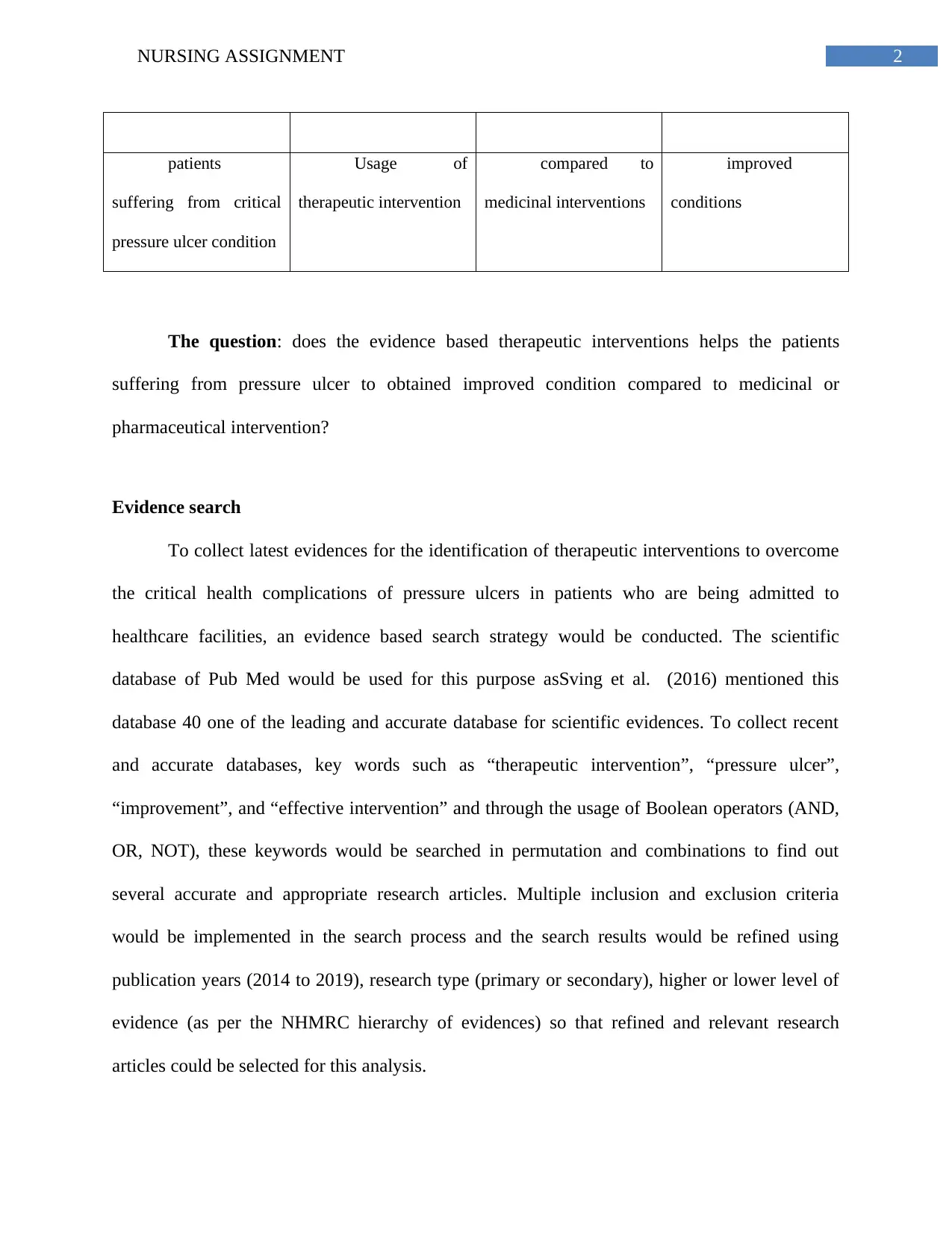
2NURSING ASSIGNMENT
patients
suffering from critical
pressure ulcer condition
Usage of
therapeutic intervention
compared to
medicinal interventions
improved
conditions
The question: does the evidence based therapeutic interventions helps the patients
suffering from pressure ulcer to obtained improved condition compared to medicinal or
pharmaceutical intervention?
Evidence search
To collect latest evidences for the identification of therapeutic interventions to overcome
the critical health complications of pressure ulcers in patients who are being admitted to
healthcare facilities, an evidence based search strategy would be conducted. The scientific
database of Pub Med would be used for this purpose asSving et al. (2016) mentioned this
database 40 one of the leading and accurate database for scientific evidences. To collect recent
and accurate databases, key words such as “therapeutic intervention”, “pressure ulcer”,
“improvement”, and “effective intervention” and through the usage of Boolean operators (AND,
OR, NOT), these keywords would be searched in permutation and combinations to find out
several accurate and appropriate research articles. Multiple inclusion and exclusion criteria
would be implemented in the search process and the search results would be refined using
publication years (2014 to 2019), research type (primary or secondary), higher or lower level of
evidence (as per the NHMRC hierarchy of evidences) so that refined and relevant research
articles could be selected for this analysis.
patients
suffering from critical
pressure ulcer condition
Usage of
therapeutic intervention
compared to
medicinal interventions
improved
conditions
The question: does the evidence based therapeutic interventions helps the patients
suffering from pressure ulcer to obtained improved condition compared to medicinal or
pharmaceutical intervention?
Evidence search
To collect latest evidences for the identification of therapeutic interventions to overcome
the critical health complications of pressure ulcers in patients who are being admitted to
healthcare facilities, an evidence based search strategy would be conducted. The scientific
database of Pub Med would be used for this purpose asSving et al. (2016) mentioned this
database 40 one of the leading and accurate database for scientific evidences. To collect recent
and accurate databases, key words such as “therapeutic intervention”, “pressure ulcer”,
“improvement”, and “effective intervention” and through the usage of Boolean operators (AND,
OR, NOT), these keywords would be searched in permutation and combinations to find out
several accurate and appropriate research articles. Multiple inclusion and exclusion criteria
would be implemented in the search process and the search results would be refined using
publication years (2014 to 2019), research type (primary or secondary), higher or lower level of
evidence (as per the NHMRC hierarchy of evidences) so that refined and relevant research
articles could be selected for this analysis.
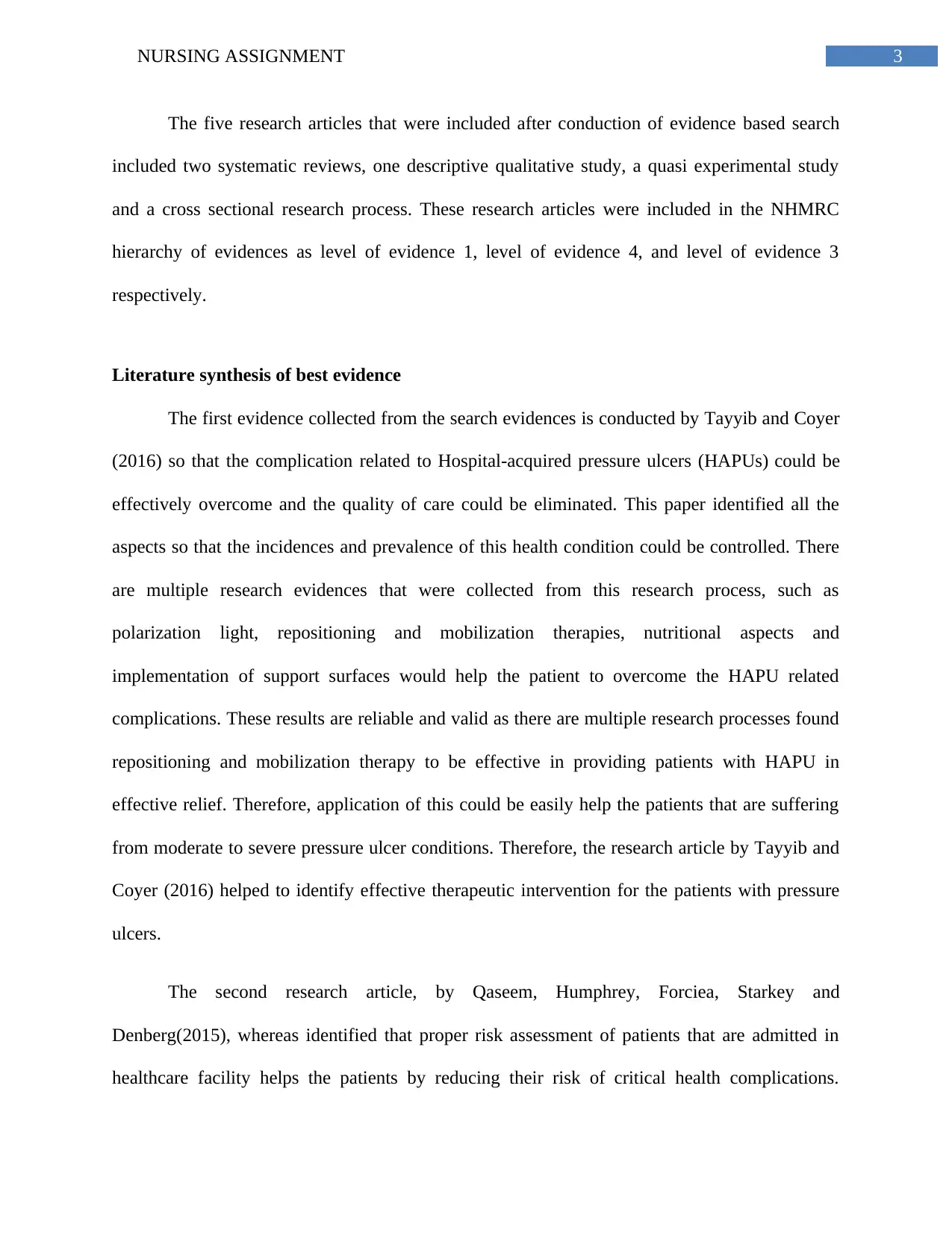
3NURSING ASSIGNMENT
The five research articles that were included after conduction of evidence based search
included two systematic reviews, one descriptive qualitative study, a quasi experimental study
and a cross sectional research process. These research articles were included in the NHMRC
hierarchy of evidences as level of evidence 1, level of evidence 4, and level of evidence 3
respectively.
Literature synthesis of best evidence
The first evidence collected from the search evidences is conducted by Tayyib and Coyer
(2016) so that the complication related to Hospital‐acquired pressure ulcers (HAPUs) could be
effectively overcome and the quality of care could be eliminated. This paper identified all the
aspects so that the incidences and prevalence of this health condition could be controlled. There
are multiple research evidences that were collected from this research process, such as
polarization light, repositioning and mobilization therapies, nutritional aspects and
implementation of support surfaces would help the patient to overcome the HAPU related
complications. These results are reliable and valid as there are multiple research processes found
repositioning and mobilization therapy to be effective in providing patients with HAPU in
effective relief. Therefore, application of this could be easily help the patients that are suffering
from moderate to severe pressure ulcer conditions. Therefore, the research article by Tayyib and
Coyer (2016) helped to identify effective therapeutic intervention for the patients with pressure
ulcers.
The second research article, by Qaseem, Humphrey, Forciea, Starkey and
Denberg(2015), whereas identified that proper risk assessment of patients that are admitted in
healthcare facility helps the patients by reducing their risk of critical health complications.
The five research articles that were included after conduction of evidence based search
included two systematic reviews, one descriptive qualitative study, a quasi experimental study
and a cross sectional research process. These research articles were included in the NHMRC
hierarchy of evidences as level of evidence 1, level of evidence 4, and level of evidence 3
respectively.
Literature synthesis of best evidence
The first evidence collected from the search evidences is conducted by Tayyib and Coyer
(2016) so that the complication related to Hospital‐acquired pressure ulcers (HAPUs) could be
effectively overcome and the quality of care could be eliminated. This paper identified all the
aspects so that the incidences and prevalence of this health condition could be controlled. There
are multiple research evidences that were collected from this research process, such as
polarization light, repositioning and mobilization therapies, nutritional aspects and
implementation of support surfaces would help the patient to overcome the HAPU related
complications. These results are reliable and valid as there are multiple research processes found
repositioning and mobilization therapy to be effective in providing patients with HAPU in
effective relief. Therefore, application of this could be easily help the patients that are suffering
from moderate to severe pressure ulcer conditions. Therefore, the research article by Tayyib and
Coyer (2016) helped to identify effective therapeutic intervention for the patients with pressure
ulcers.
The second research article, by Qaseem, Humphrey, Forciea, Starkey and
Denberg(2015), whereas identified that proper risk assessment of patients that are admitted in
healthcare facility helps the patients by reducing their risk of critical health complications.
Secure Best Marks with AI Grader
Need help grading? Try our AI Grader for instant feedback on your assignments.
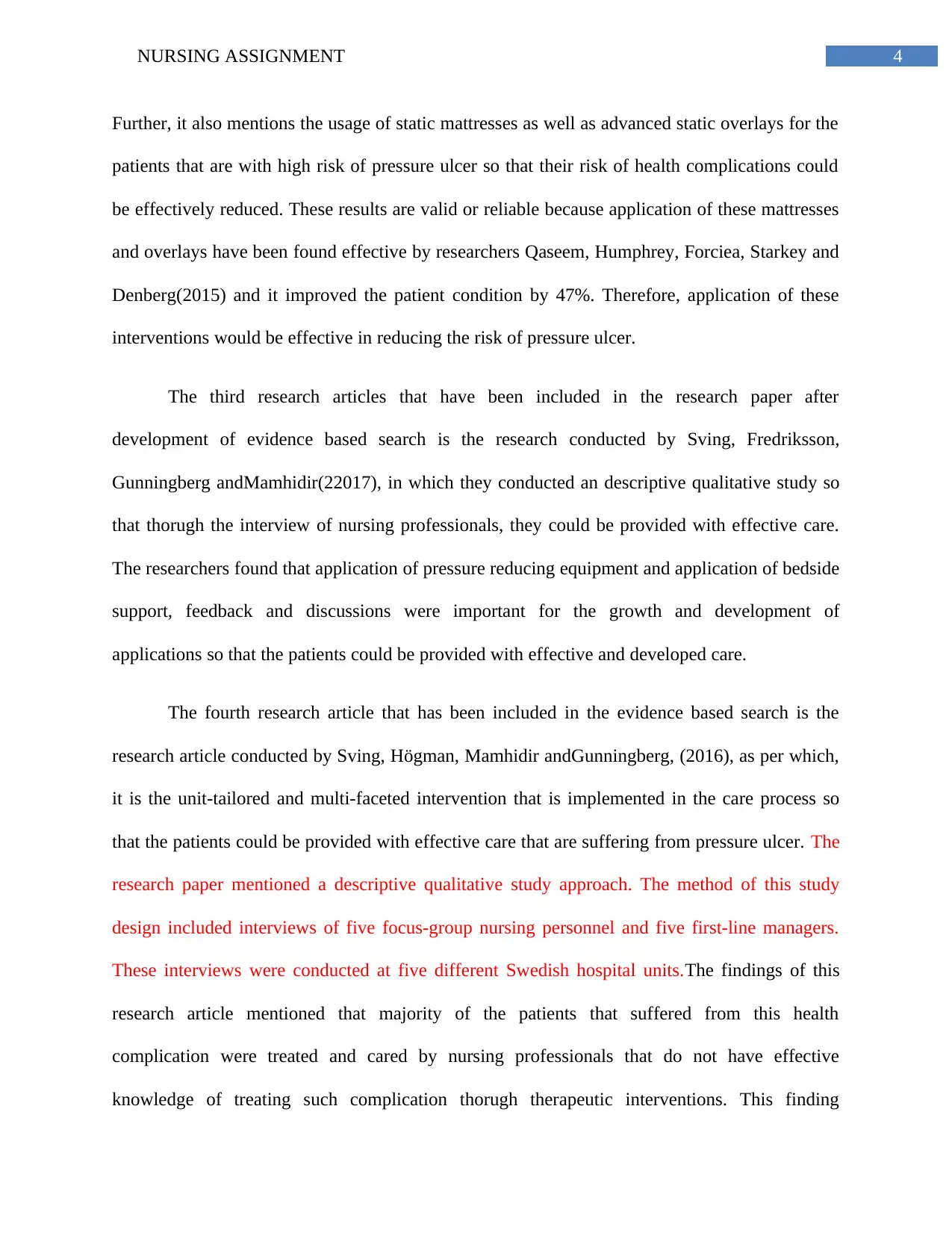
4NURSING ASSIGNMENT
Further, it also mentions the usage of static mattresses as well as advanced static overlays for the
patients that are with high risk of pressure ulcer so that their risk of health complications could
be effectively reduced. These results are valid or reliable because application of these mattresses
and overlays have been found effective by researchers Qaseem, Humphrey, Forciea, Starkey and
Denberg(2015) and it improved the patient condition by 47%. Therefore, application of these
interventions would be effective in reducing the risk of pressure ulcer.
The third research articles that have been included in the research paper after
development of evidence based search is the research conducted by Sving, Fredriksson,
Gunningberg andMamhidir(22017), in which they conducted an descriptive qualitative study so
that thorugh the interview of nursing professionals, they could be provided with effective care.
The researchers found that application of pressure reducing equipment and application of bedside
support, feedback and discussions were important for the growth and development of
applications so that the patients could be provided with effective and developed care.
The fourth research article that has been included in the evidence based search is the
research article conducted by Sving, Högman, Mamhidir andGunningberg, (2016), as per which,
it is the unit-tailored and multi-faceted intervention that is implemented in the care process so
that the patients could be provided with effective care that are suffering from pressure ulcer. The
research paper mentioned a descriptive qualitative study approach. The method of this study
design included interviews of five focus-group nursing personnel and five first-line managers.
These interviews were conducted at five different Swedish hospital units.The findings of this
research article mentioned that majority of the patients that suffered from this health
complication were treated and cared by nursing professionals that do not have effective
knowledge of treating such complication thorugh therapeutic interventions. This finding
Further, it also mentions the usage of static mattresses as well as advanced static overlays for the
patients that are with high risk of pressure ulcer so that their risk of health complications could
be effectively reduced. These results are valid or reliable because application of these mattresses
and overlays have been found effective by researchers Qaseem, Humphrey, Forciea, Starkey and
Denberg(2015) and it improved the patient condition by 47%. Therefore, application of these
interventions would be effective in reducing the risk of pressure ulcer.
The third research articles that have been included in the research paper after
development of evidence based search is the research conducted by Sving, Fredriksson,
Gunningberg andMamhidir(22017), in which they conducted an descriptive qualitative study so
that thorugh the interview of nursing professionals, they could be provided with effective care.
The researchers found that application of pressure reducing equipment and application of bedside
support, feedback and discussions were important for the growth and development of
applications so that the patients could be provided with effective and developed care.
The fourth research article that has been included in the evidence based search is the
research article conducted by Sving, Högman, Mamhidir andGunningberg, (2016), as per which,
it is the unit-tailored and multi-faceted intervention that is implemented in the care process so
that the patients could be provided with effective care that are suffering from pressure ulcer. The
research paper mentioned a descriptive qualitative study approach. The method of this study
design included interviews of five focus-group nursing personnel and five first-line managers.
These interviews were conducted at five different Swedish hospital units.The findings of this
research article mentioned that majority of the patients that suffered from this health
complication were treated and cared by nursing professionals that do not have effective
knowledge of treating such complication thorugh therapeutic interventions. This finding
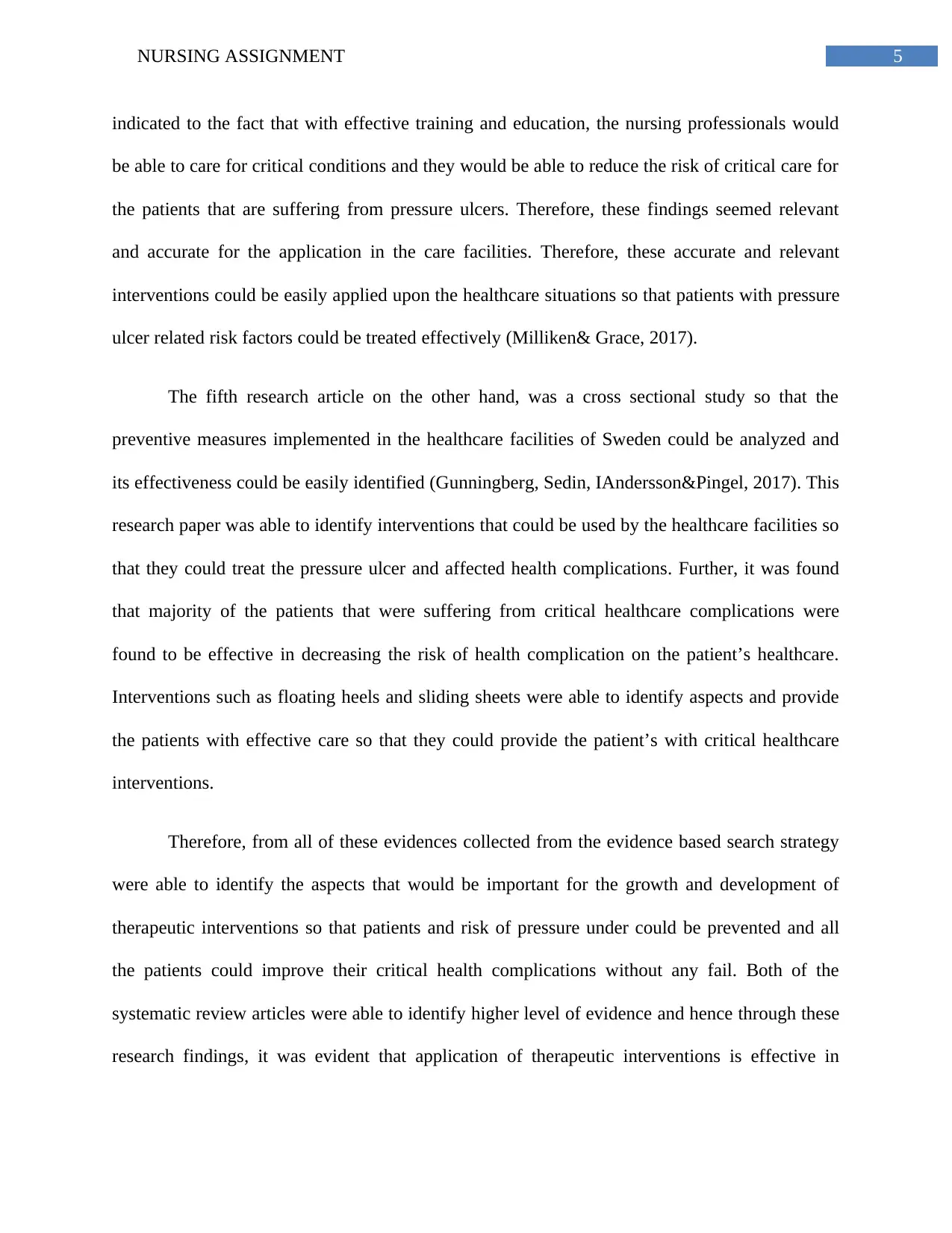
5NURSING ASSIGNMENT
indicated to the fact that with effective training and education, the nursing professionals would
be able to care for critical conditions and they would be able to reduce the risk of critical care for
the patients that are suffering from pressure ulcers. Therefore, these findings seemed relevant
and accurate for the application in the care facilities. Therefore, these accurate and relevant
interventions could be easily applied upon the healthcare situations so that patients with pressure
ulcer related risk factors could be treated effectively (Milliken& Grace, 2017).
The fifth research article on the other hand, was a cross sectional study so that the
preventive measures implemented in the healthcare facilities of Sweden could be analyzed and
its effectiveness could be easily identified (Gunningberg, Sedin, IAndersson&Pingel, 2017). This
research paper was able to identify interventions that could be used by the healthcare facilities so
that they could treat the pressure ulcer and affected health complications. Further, it was found
that majority of the patients that were suffering from critical healthcare complications were
found to be effective in decreasing the risk of health complication on the patient’s healthcare.
Interventions such as floating heels and sliding sheets were able to identify aspects and provide
the patients with effective care so that they could provide the patient’s with critical healthcare
interventions.
Therefore, from all of these evidences collected from the evidence based search strategy
were able to identify the aspects that would be important for the growth and development of
therapeutic interventions so that patients and risk of pressure under could be prevented and all
the patients could improve their critical health complications without any fail. Both of the
systematic review articles were able to identify higher level of evidence and hence through these
research findings, it was evident that application of therapeutic interventions is effective in
indicated to the fact that with effective training and education, the nursing professionals would
be able to care for critical conditions and they would be able to reduce the risk of critical care for
the patients that are suffering from pressure ulcers. Therefore, these findings seemed relevant
and accurate for the application in the care facilities. Therefore, these accurate and relevant
interventions could be easily applied upon the healthcare situations so that patients with pressure
ulcer related risk factors could be treated effectively (Milliken& Grace, 2017).
The fifth research article on the other hand, was a cross sectional study so that the
preventive measures implemented in the healthcare facilities of Sweden could be analyzed and
its effectiveness could be easily identified (Gunningberg, Sedin, IAndersson&Pingel, 2017). This
research paper was able to identify interventions that could be used by the healthcare facilities so
that they could treat the pressure ulcer and affected health complications. Further, it was found
that majority of the patients that were suffering from critical healthcare complications were
found to be effective in decreasing the risk of health complication on the patient’s healthcare.
Interventions such as floating heels and sliding sheets were able to identify aspects and provide
the patients with effective care so that they could provide the patient’s with critical healthcare
interventions.
Therefore, from all of these evidences collected from the evidence based search strategy
were able to identify the aspects that would be important for the growth and development of
therapeutic interventions so that patients and risk of pressure under could be prevented and all
the patients could improve their critical health complications without any fail. Both of the
systematic review articles were able to identify higher level of evidence and hence through these
research findings, it was evident that application of therapeutic interventions is effective in
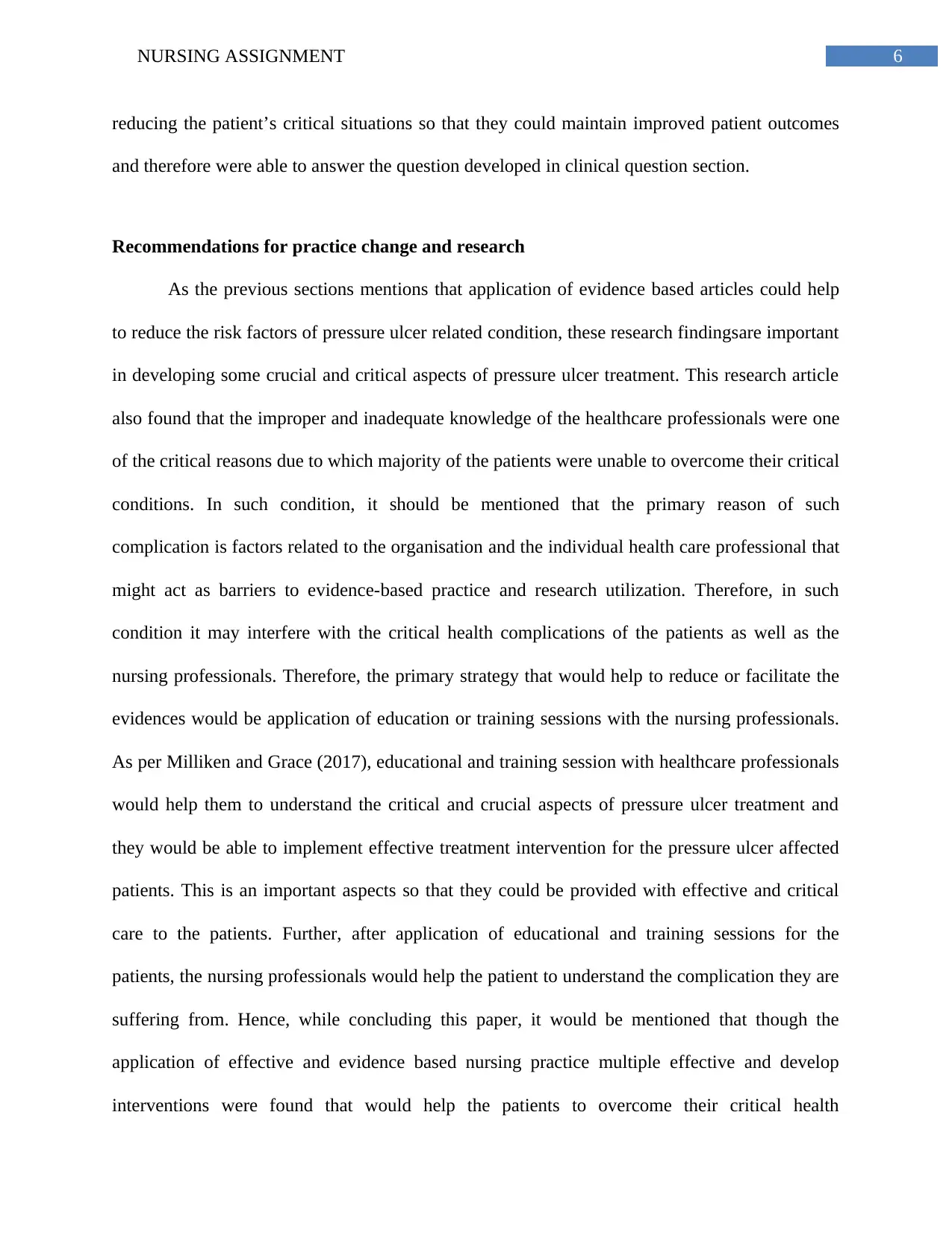
6NURSING ASSIGNMENT
reducing the patient’s critical situations so that they could maintain improved patient outcomes
and therefore were able to answer the question developed in clinical question section.
Recommendations for practice change and research
As the previous sections mentions that application of evidence based articles could help
to reduce the risk factors of pressure ulcer related condition, these research findingsare important
in developing some crucial and critical aspects of pressure ulcer treatment. This research article
also found that the improper and inadequate knowledge of the healthcare professionals were one
of the critical reasons due to which majority of the patients were unable to overcome their critical
conditions. In such condition, it should be mentioned that the primary reason of such
complication is factors related to the organisation and the individual health care professional that
might act as barriers to evidence-based practice and research utilization. Therefore, in such
condition it may interfere with the critical health complications of the patients as well as the
nursing professionals. Therefore, the primary strategy that would help to reduce or facilitate the
evidences would be application of education or training sessions with the nursing professionals.
As per Milliken and Grace (2017), educational and training session with healthcare professionals
would help them to understand the critical and crucial aspects of pressure ulcer treatment and
they would be able to implement effective treatment intervention for the pressure ulcer affected
patients. This is an important aspects so that they could be provided with effective and critical
care to the patients. Further, after application of educational and training sessions for the
patients, the nursing professionals would help the patient to understand the complication they are
suffering from. Hence, while concluding this paper, it would be mentioned that though the
application of effective and evidence based nursing practice multiple effective and develop
interventions were found that would help the patients to overcome their critical health
reducing the patient’s critical situations so that they could maintain improved patient outcomes
and therefore were able to answer the question developed in clinical question section.
Recommendations for practice change and research
As the previous sections mentions that application of evidence based articles could help
to reduce the risk factors of pressure ulcer related condition, these research findingsare important
in developing some crucial and critical aspects of pressure ulcer treatment. This research article
also found that the improper and inadequate knowledge of the healthcare professionals were one
of the critical reasons due to which majority of the patients were unable to overcome their critical
conditions. In such condition, it should be mentioned that the primary reason of such
complication is factors related to the organisation and the individual health care professional that
might act as barriers to evidence-based practice and research utilization. Therefore, in such
condition it may interfere with the critical health complications of the patients as well as the
nursing professionals. Therefore, the primary strategy that would help to reduce or facilitate the
evidences would be application of education or training sessions with the nursing professionals.
As per Milliken and Grace (2017), educational and training session with healthcare professionals
would help them to understand the critical and crucial aspects of pressure ulcer treatment and
they would be able to implement effective treatment intervention for the pressure ulcer affected
patients. This is an important aspects so that they could be provided with effective and critical
care to the patients. Further, after application of educational and training sessions for the
patients, the nursing professionals would help the patient to understand the complication they are
suffering from. Hence, while concluding this paper, it would be mentioned that though the
application of effective and evidence based nursing practice multiple effective and develop
interventions were found that would help the patients to overcome their critical health
Paraphrase This Document
Need a fresh take? Get an instant paraphrase of this document with our AI Paraphraser
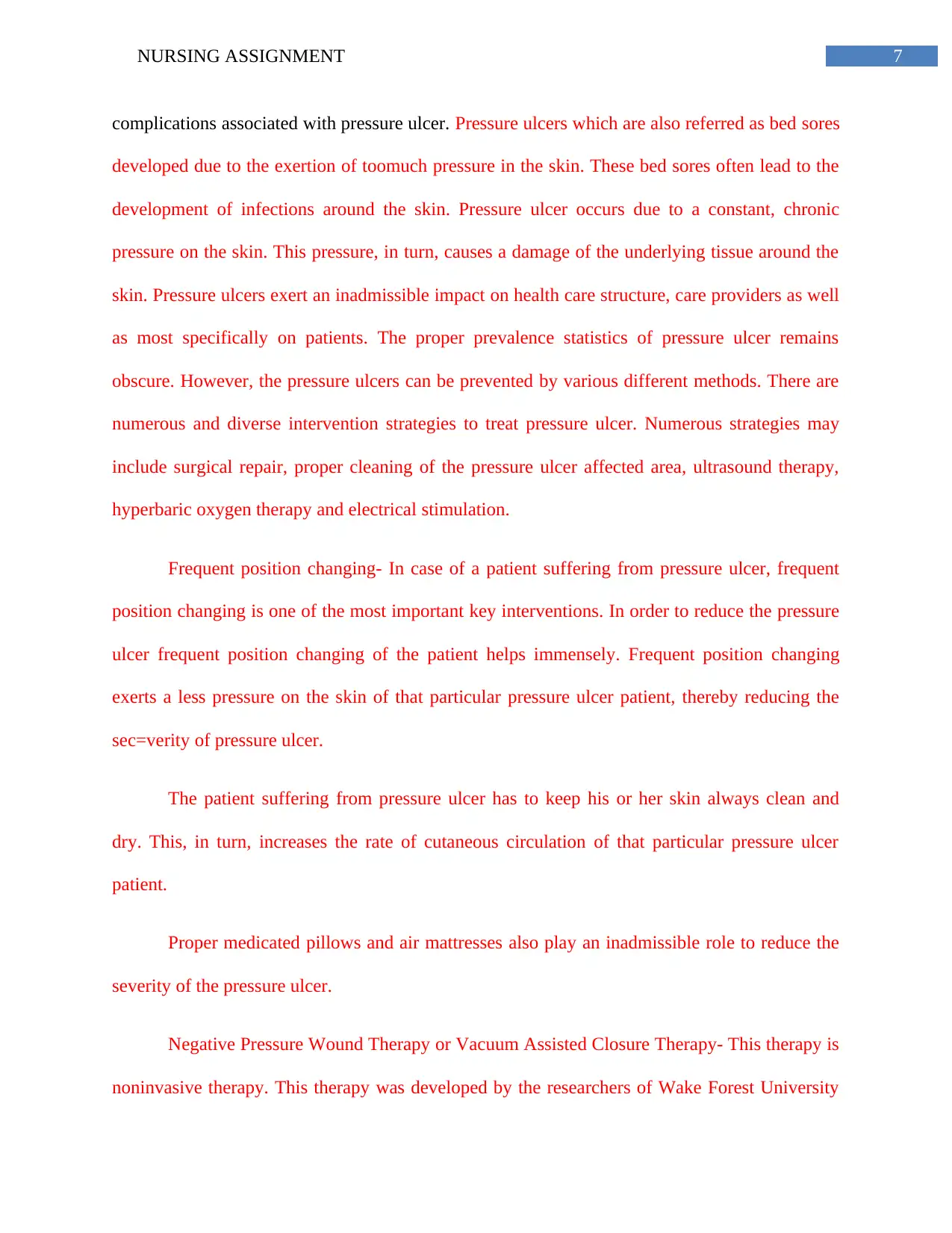
7NURSING ASSIGNMENT
complications associated with pressure ulcer. Pressure ulcers which are also referred as bed sores
developed due to the exertion of toomuch pressure in the skin. These bed sores often lead to the
development of infections around the skin. Pressure ulcer occurs due to a constant, chronic
pressure on the skin. This pressure, in turn, causes a damage of the underlying tissue around the
skin. Pressure ulcers exert an inadmissible impact on health care structure, care providers as well
as most specifically on patients. The proper prevalence statistics of pressure ulcer remains
obscure. However, the pressure ulcers can be prevented by various different methods. There are
numerous and diverse intervention strategies to treat pressure ulcer. Numerous strategies may
include surgical repair, proper cleaning of the pressure ulcer affected area, ultrasound therapy,
hyperbaric oxygen therapy and electrical stimulation.
Frequent position changing- In case of a patient suffering from pressure ulcer, frequent
position changing is one of the most important key interventions. In order to reduce the pressure
ulcer frequent position changing of the patient helps immensely. Frequent position changing
exerts a less pressure on the skin of that particular pressure ulcer patient, thereby reducing the
sec=verity of pressure ulcer.
The patient suffering from pressure ulcer has to keep his or her skin always clean and
dry. This, in turn, increases the rate of cutaneous circulation of that particular pressure ulcer
patient.
Proper medicated pillows and air mattresses also play an inadmissible role to reduce the
severity of the pressure ulcer.
Negative Pressure Wound Therapy or Vacuum Assisted Closure Therapy- This therapy is
noninvasive therapy. This therapy was developed by the researchers of Wake Forest University
complications associated with pressure ulcer. Pressure ulcers which are also referred as bed sores
developed due to the exertion of toomuch pressure in the skin. These bed sores often lead to the
development of infections around the skin. Pressure ulcer occurs due to a constant, chronic
pressure on the skin. This pressure, in turn, causes a damage of the underlying tissue around the
skin. Pressure ulcers exert an inadmissible impact on health care structure, care providers as well
as most specifically on patients. The proper prevalence statistics of pressure ulcer remains
obscure. However, the pressure ulcers can be prevented by various different methods. There are
numerous and diverse intervention strategies to treat pressure ulcer. Numerous strategies may
include surgical repair, proper cleaning of the pressure ulcer affected area, ultrasound therapy,
hyperbaric oxygen therapy and electrical stimulation.
Frequent position changing- In case of a patient suffering from pressure ulcer, frequent
position changing is one of the most important key interventions. In order to reduce the pressure
ulcer frequent position changing of the patient helps immensely. Frequent position changing
exerts a less pressure on the skin of that particular pressure ulcer patient, thereby reducing the
sec=verity of pressure ulcer.
The patient suffering from pressure ulcer has to keep his or her skin always clean and
dry. This, in turn, increases the rate of cutaneous circulation of that particular pressure ulcer
patient.
Proper medicated pillows and air mattresses also play an inadmissible role to reduce the
severity of the pressure ulcer.
Negative Pressure Wound Therapy or Vacuum Assisted Closure Therapy- This therapy is
noninvasive therapy. This therapy was developed by the researchers of Wake Forest University
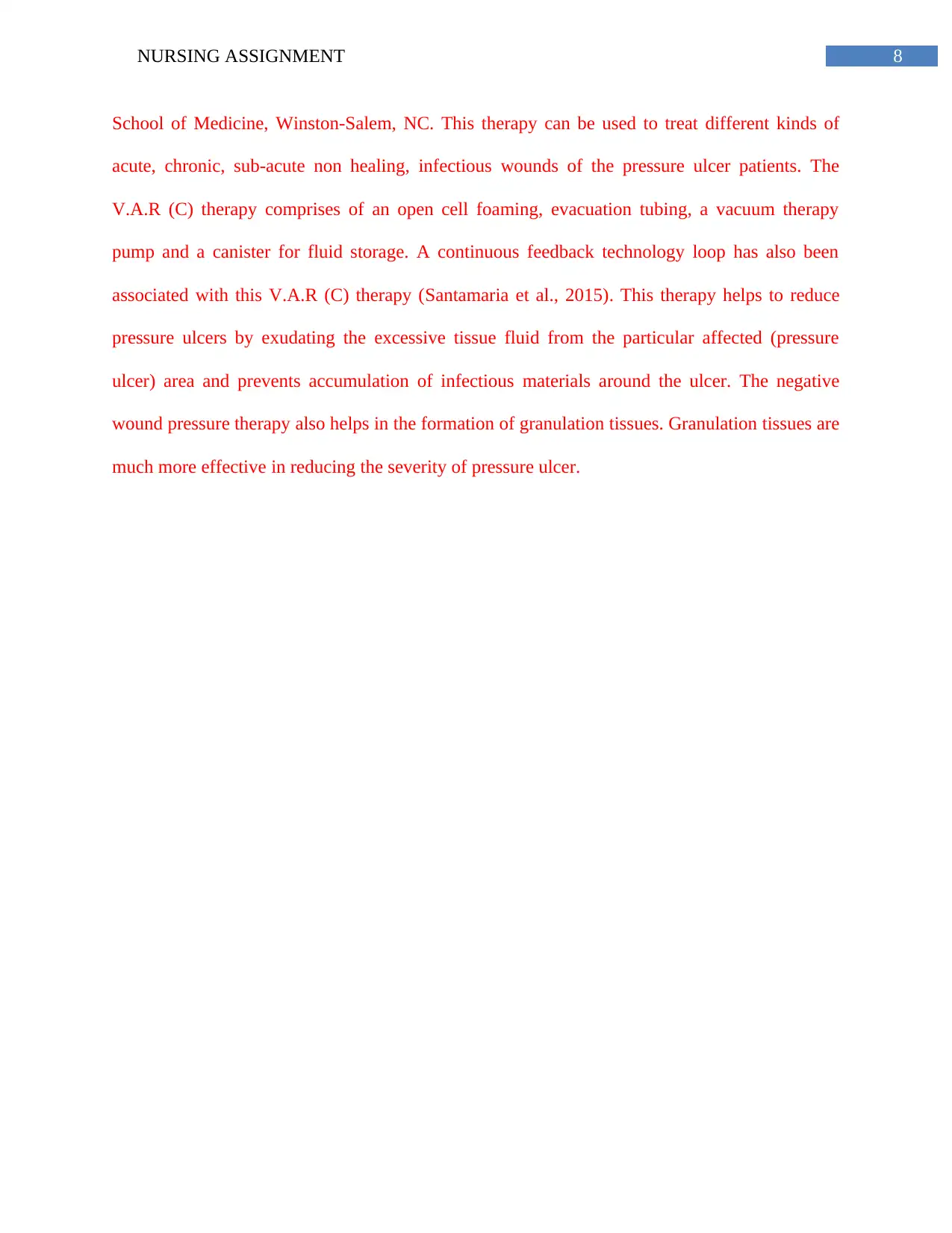
8NURSING ASSIGNMENT
School of Medicine, Winston-Salem, NC. This therapy can be used to treat different kinds of
acute, chronic, sub-acute non healing, infectious wounds of the pressure ulcer patients. The
V.A.R (C) therapy comprises of an open cell foaming, evacuation tubing, a vacuum therapy
pump and a canister for fluid storage. A continuous feedback technology loop has also been
associated with this V.A.R (C) therapy (Santamaria et al., 2015). This therapy helps to reduce
pressure ulcers by exudating the excessive tissue fluid from the particular affected (pressure
ulcer) area and prevents accumulation of infectious materials around the ulcer. The negative
wound pressure therapy also helps in the formation of granulation tissues. Granulation tissues are
much more effective in reducing the severity of pressure ulcer.
School of Medicine, Winston-Salem, NC. This therapy can be used to treat different kinds of
acute, chronic, sub-acute non healing, infectious wounds of the pressure ulcer patients. The
V.A.R (C) therapy comprises of an open cell foaming, evacuation tubing, a vacuum therapy
pump and a canister for fluid storage. A continuous feedback technology loop has also been
associated with this V.A.R (C) therapy (Santamaria et al., 2015). This therapy helps to reduce
pressure ulcers by exudating the excessive tissue fluid from the particular affected (pressure
ulcer) area and prevents accumulation of infectious materials around the ulcer. The negative
wound pressure therapy also helps in the formation of granulation tissues. Granulation tissues are
much more effective in reducing the severity of pressure ulcer.
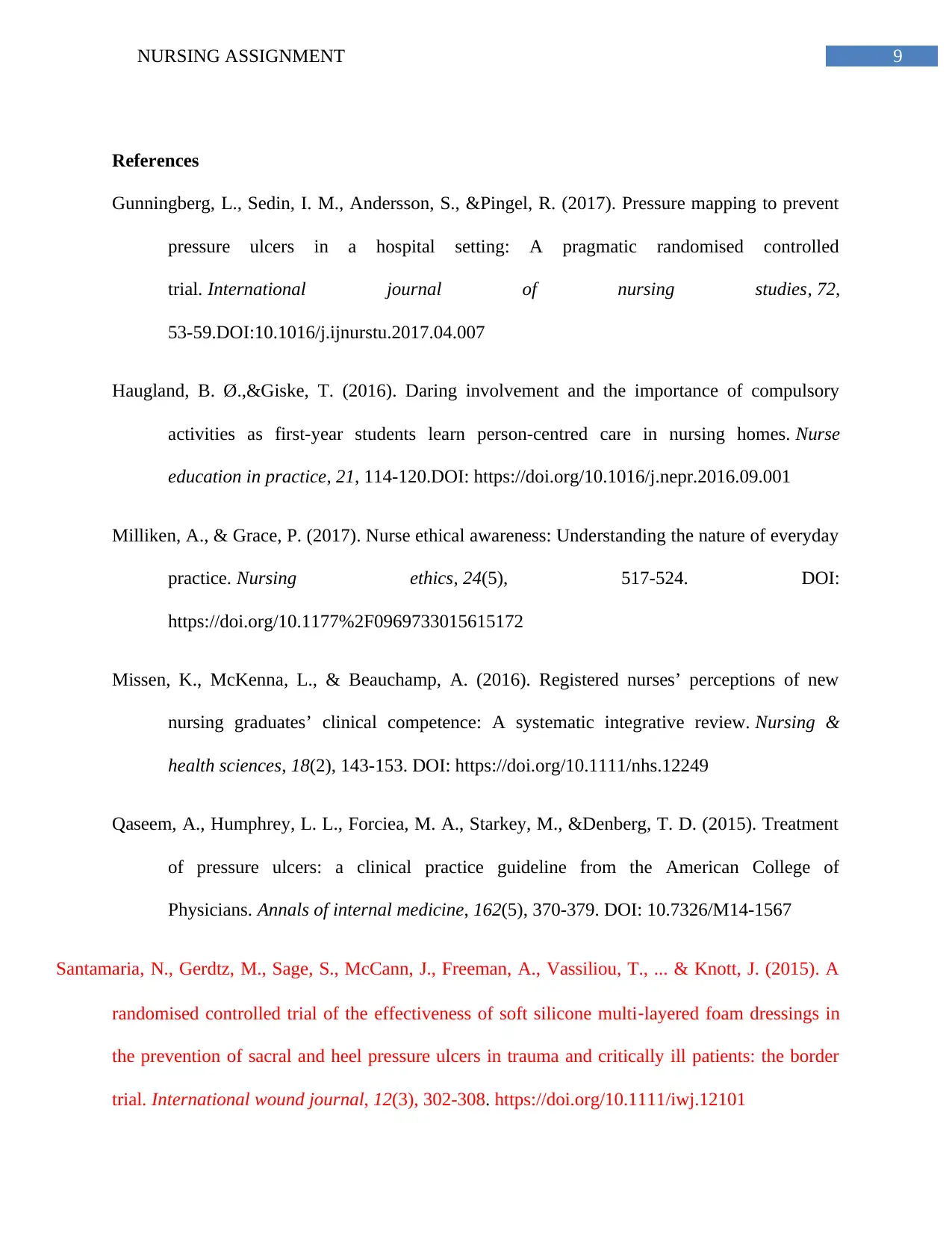
9NURSING ASSIGNMENT
References
Gunningberg, L., Sedin, I. M., Andersson, S., &Pingel, R. (2017). Pressure mapping to prevent
pressure ulcers in a hospital setting: A pragmatic randomised controlled
trial. International journal of nursing studies, 72,
53-59.DOI:10.1016/j.ijnurstu.2017.04.007
Haugland, B. Ø.,&Giske, T. (2016). Daring involvement and the importance of compulsory
activities as first-year students learn person-centred care in nursing homes. Nurse
education in practice, 21, 114-120.DOI: https://doi.org/10.1016/j.nepr.2016.09.001
Milliken, A., & Grace, P. (2017). Nurse ethical awareness: Understanding the nature of everyday
practice. Nursing ethics, 24(5), 517-524. DOI:
https://doi.org/10.1177%2F0969733015615172
Missen, K., McKenna, L., & Beauchamp, A. (2016). Registered nurses’ perceptions of new
nursing graduates’ clinical competence: A systematic integrative review. Nursing &
health sciences, 18(2), 143-153. DOI: https://doi.org/10.1111/nhs.12249
Qaseem, A., Humphrey, L. L., Forciea, M. A., Starkey, M., &Denberg, T. D. (2015). Treatment
of pressure ulcers: a clinical practice guideline from the American College of
Physicians. Annals of internal medicine, 162(5), 370-379. DOI: 10.7326/M14-1567
Santamaria, N., Gerdtz, M., Sage, S., McCann, J., Freeman, A., Vassiliou, T., ... & Knott, J. (2015). A
randomised controlled trial of the effectiveness of soft silicone multi‐layered foam dressings in
the prevention of sacral and heel pressure ulcers in trauma and critically ill patients: the border
trial. International wound journal, 12(3), 302-308. https://doi.org/10.1111/iwj.12101
References
Gunningberg, L., Sedin, I. M., Andersson, S., &Pingel, R. (2017). Pressure mapping to prevent
pressure ulcers in a hospital setting: A pragmatic randomised controlled
trial. International journal of nursing studies, 72,
53-59.DOI:10.1016/j.ijnurstu.2017.04.007
Haugland, B. Ø.,&Giske, T. (2016). Daring involvement and the importance of compulsory
activities as first-year students learn person-centred care in nursing homes. Nurse
education in practice, 21, 114-120.DOI: https://doi.org/10.1016/j.nepr.2016.09.001
Milliken, A., & Grace, P. (2017). Nurse ethical awareness: Understanding the nature of everyday
practice. Nursing ethics, 24(5), 517-524. DOI:
https://doi.org/10.1177%2F0969733015615172
Missen, K., McKenna, L., & Beauchamp, A. (2016). Registered nurses’ perceptions of new
nursing graduates’ clinical competence: A systematic integrative review. Nursing &
health sciences, 18(2), 143-153. DOI: https://doi.org/10.1111/nhs.12249
Qaseem, A., Humphrey, L. L., Forciea, M. A., Starkey, M., &Denberg, T. D. (2015). Treatment
of pressure ulcers: a clinical practice guideline from the American College of
Physicians. Annals of internal medicine, 162(5), 370-379. DOI: 10.7326/M14-1567
Santamaria, N., Gerdtz, M., Sage, S., McCann, J., Freeman, A., Vassiliou, T., ... & Knott, J. (2015). A
randomised controlled trial of the effectiveness of soft silicone multi‐layered foam dressings in
the prevention of sacral and heel pressure ulcers in trauma and critically ill patients: the border
trial. International wound journal, 12(3), 302-308. https://doi.org/10.1111/iwj.12101
Secure Best Marks with AI Grader
Need help grading? Try our AI Grader for instant feedback on your assignments.
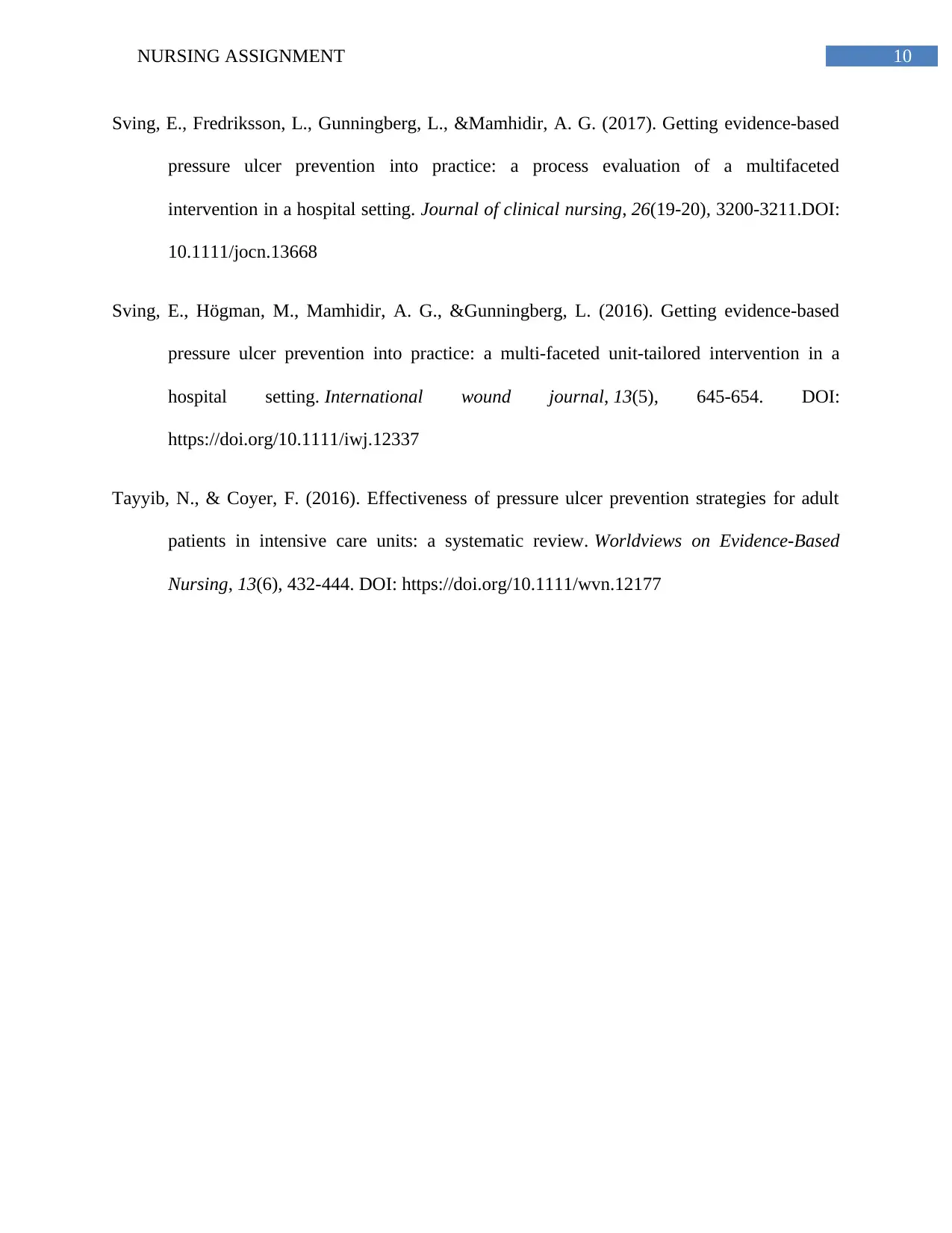
10NURSING ASSIGNMENT
Sving, E., Fredriksson, L., Gunningberg, L., &Mamhidir, A. G. (2017). Getting evidence‐based
pressure ulcer prevention into practice: a process evaluation of a multifaceted
intervention in a hospital setting. Journal of clinical nursing, 26(19-20), 3200-3211.DOI:
10.1111/jocn.13668
Sving, E., Högman, M., Mamhidir, A. G., &Gunningberg, L. (2016). Getting evidence‐based
pressure ulcer prevention into practice: a multi‐faceted unit‐tailored intervention in a
hospital setting. International wound journal, 13(5), 645-654. DOI:
https://doi.org/10.1111/iwj.12337
Tayyib, N., & Coyer, F. (2016). Effectiveness of pressure ulcer prevention strategies for adult
patients in intensive care units: a systematic review. Worldviews on Evidence‐Based
Nursing, 13(6), 432-444. DOI: https://doi.org/10.1111/wvn.12177
Sving, E., Fredriksson, L., Gunningberg, L., &Mamhidir, A. G. (2017). Getting evidence‐based
pressure ulcer prevention into practice: a process evaluation of a multifaceted
intervention in a hospital setting. Journal of clinical nursing, 26(19-20), 3200-3211.DOI:
10.1111/jocn.13668
Sving, E., Högman, M., Mamhidir, A. G., &Gunningberg, L. (2016). Getting evidence‐based
pressure ulcer prevention into practice: a multi‐faceted unit‐tailored intervention in a
hospital setting. International wound journal, 13(5), 645-654. DOI:
https://doi.org/10.1111/iwj.12337
Tayyib, N., & Coyer, F. (2016). Effectiveness of pressure ulcer prevention strategies for adult
patients in intensive care units: a systematic review. Worldviews on Evidence‐Based
Nursing, 13(6), 432-444. DOI: https://doi.org/10.1111/wvn.12177
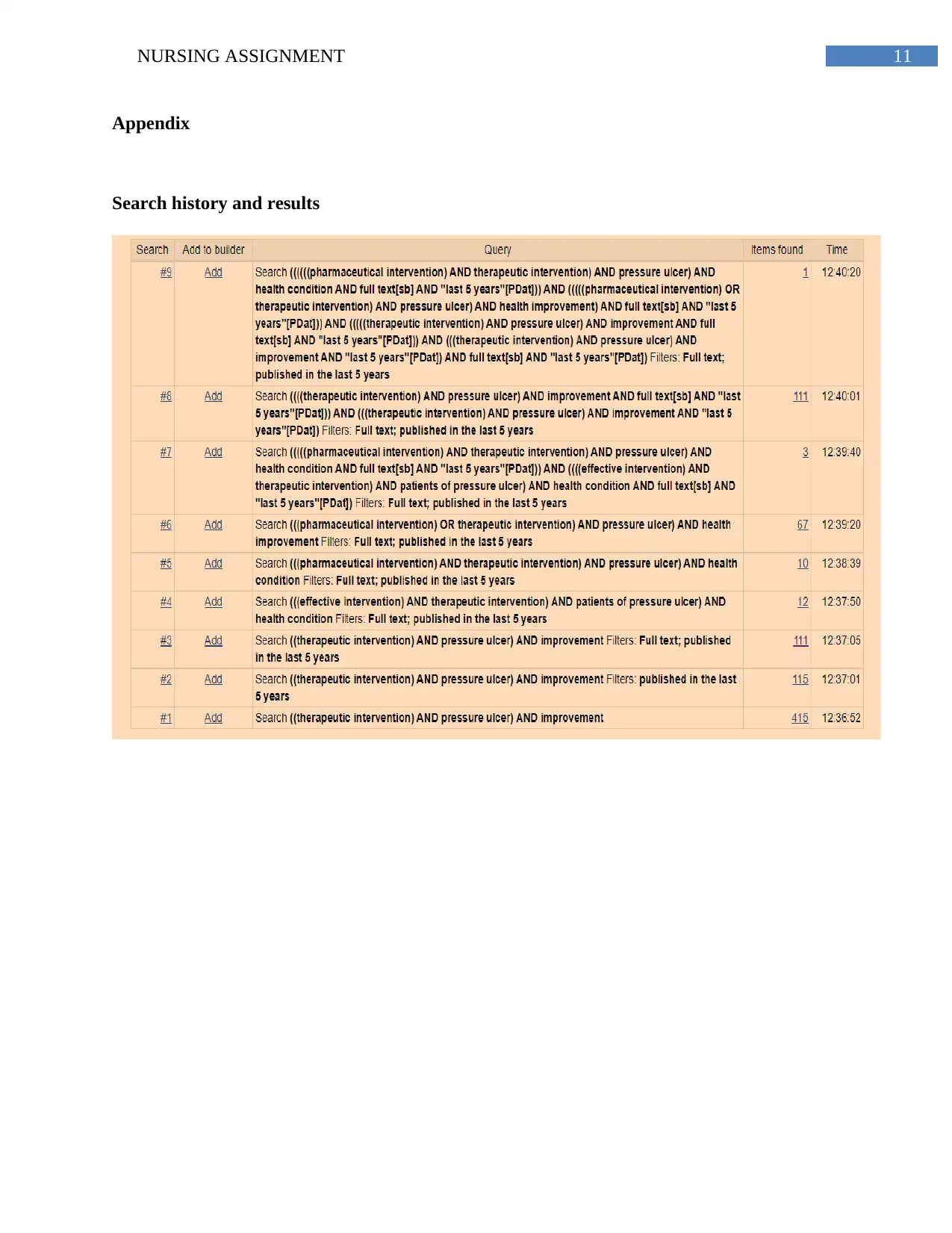
11NURSING ASSIGNMENT
Appendix
Search history and results
Appendix
Search history and results
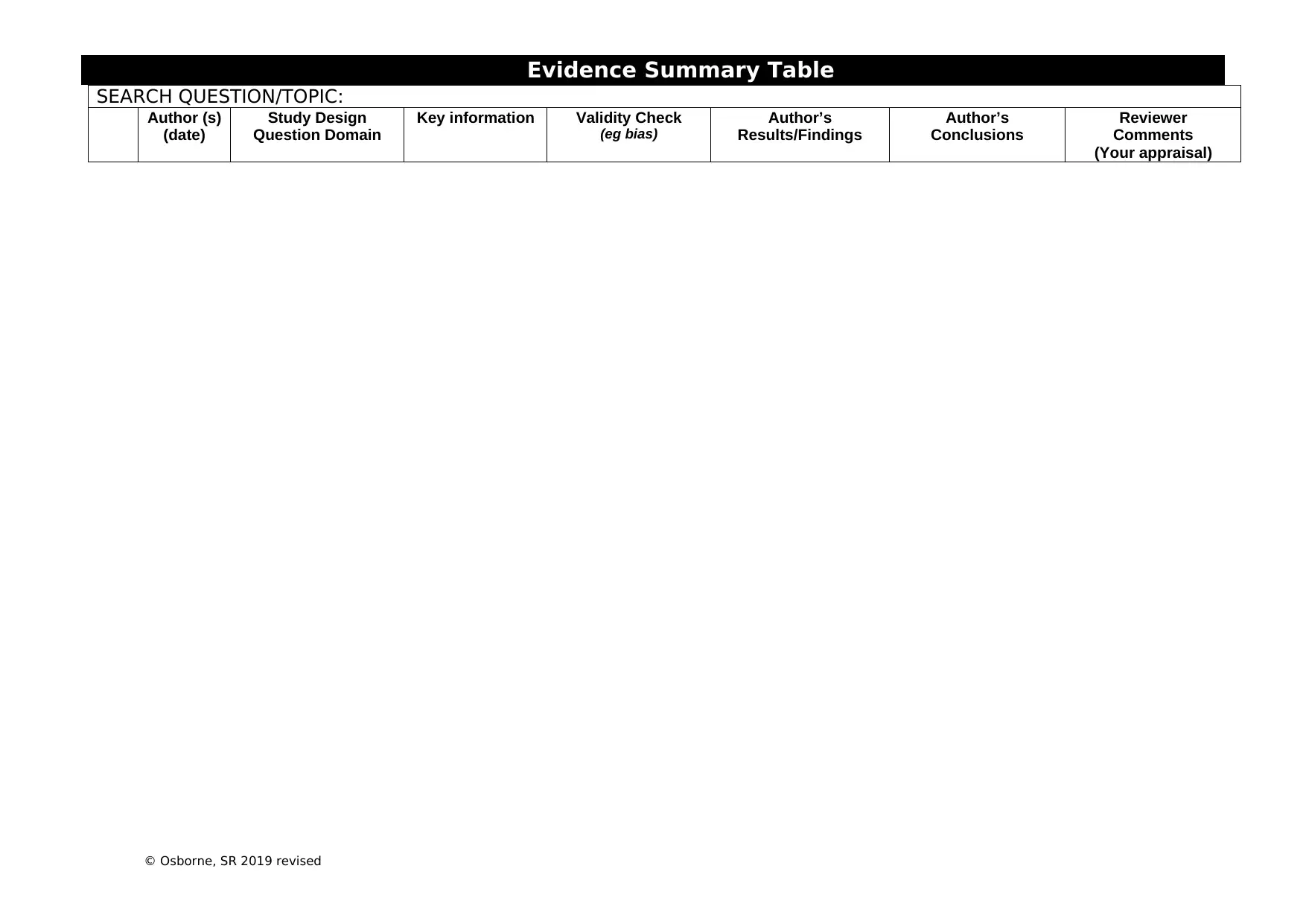
Evidence Summary Table
SEARCH QUESTION/TOPIC:
Author (s)
(date)
Study Design
Question Domain
Key information Validity Check
(eg bias)
Author’s
Results/Findings
Author’s
Conclusions
Reviewer
Comments
(Your appraisal)
© Osborne, SR 2019 revised
SEARCH QUESTION/TOPIC:
Author (s)
(date)
Study Design
Question Domain
Key information Validity Check
(eg bias)
Author’s
Results/Findings
Author’s
Conclusions
Reviewer
Comments
(Your appraisal)
© Osborne, SR 2019 revised
Paraphrase This Document
Need a fresh take? Get an instant paraphrase of this document with our AI Paraphraser
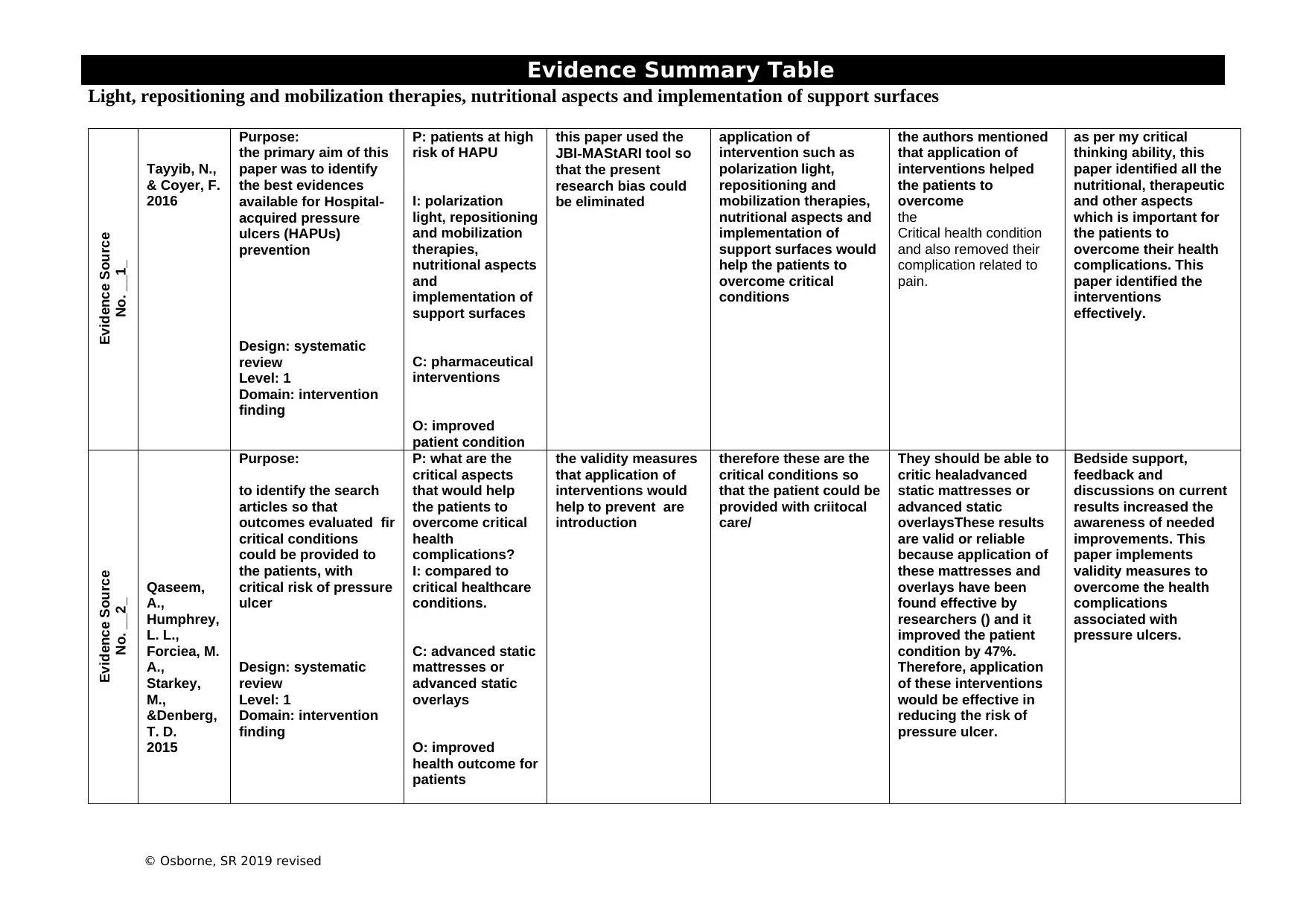
Evidence Summary Table
Light, repositioning and mobilization therapies, nutritional aspects and implementation of support surfaces
Evidence Source
No. __1_
Tayyib, N.,
& Coyer, F.
2016
Purpose:
the primary aim of this
paper was to identify
the best evidences
available for Hospital‐
acquired pressure
ulcers (HAPUs)
prevention
Design: systematic
review
Level: 1
Domain: intervention
finding
P: patients at high
risk of HAPU
I: polarization
light, repositioning
and mobilization
therapies,
nutritional aspects
and
implementation of
support surfaces
C: pharmaceutical
interventions
O: improved
patient condition
this paper used the
JBI‐MAStARI tool so
that the present
research bias could
be eliminated
application of
intervention such as
polarization light,
repositioning and
mobilization therapies,
nutritional aspects and
implementation of
support surfaces would
help the patients to
overcome critical
conditions
the authors mentioned
that application of
interventions helped
the patients to
overcome
the
Critical health condition
and also removed their
complication related to
pain.
as per my critical
thinking ability, this
paper identified all the
nutritional, therapeutic
and other aspects
which is important for
the patients to
overcome their health
complications. This
paper identified the
interventions
effectively.
Evidence Source
No. __2_ Qaseem,
A.,
Humphrey,
L. L.,
Forciea, M.
A.,
Starkey,
M.,
&Denberg,
T. D.
2015
Purpose:
to identify the search
articles so that
outcomes evaluated fir
critical conditions
could be provided to
the patients, with
critical risk of pressure
ulcer
Design: systematic
review
Level: 1
Domain: intervention
finding
P: what are the
critical aspects
that would help
the patients to
overcome critical
health
complications?
I: compared to
critical healthcare
conditions.
C: advanced static
mattresses or
advanced static
overlays
O: improved
health outcome for
patients
the validity measures
that application of
interventions would
help to prevent are
introduction
therefore these are the
critical conditions so
that the patient could be
provided with criitocal
care/
They should be able to
critic healadvanced
static mattresses or
advanced static
overlaysThese results
are valid or reliable
because application of
these mattresses and
overlays have been
found effective by
researchers () and it
improved the patient
condition by 47%.
Therefore, application
of these interventions
would be effective in
reducing the risk of
pressure ulcer.
Bedside support,
feedback and
discussions on current
results increased the
awareness of needed
improvements. This
paper implements
validity measures to
overcome the health
complications
associated with
pressure ulcers.
© Osborne, SR 2019 revised
Light, repositioning and mobilization therapies, nutritional aspects and implementation of support surfaces
Evidence Source
No. __1_
Tayyib, N.,
& Coyer, F.
2016
Purpose:
the primary aim of this
paper was to identify
the best evidences
available for Hospital‐
acquired pressure
ulcers (HAPUs)
prevention
Design: systematic
review
Level: 1
Domain: intervention
finding
P: patients at high
risk of HAPU
I: polarization
light, repositioning
and mobilization
therapies,
nutritional aspects
and
implementation of
support surfaces
C: pharmaceutical
interventions
O: improved
patient condition
this paper used the
JBI‐MAStARI tool so
that the present
research bias could
be eliminated
application of
intervention such as
polarization light,
repositioning and
mobilization therapies,
nutritional aspects and
implementation of
support surfaces would
help the patients to
overcome critical
conditions
the authors mentioned
that application of
interventions helped
the patients to
overcome
the
Critical health condition
and also removed their
complication related to
pain.
as per my critical
thinking ability, this
paper identified all the
nutritional, therapeutic
and other aspects
which is important for
the patients to
overcome their health
complications. This
paper identified the
interventions
effectively.
Evidence Source
No. __2_ Qaseem,
A.,
Humphrey,
L. L.,
Forciea, M.
A.,
Starkey,
M.,
&Denberg,
T. D.
2015
Purpose:
to identify the search
articles so that
outcomes evaluated fir
critical conditions
could be provided to
the patients, with
critical risk of pressure
ulcer
Design: systematic
review
Level: 1
Domain: intervention
finding
P: what are the
critical aspects
that would help
the patients to
overcome critical
health
complications?
I: compared to
critical healthcare
conditions.
C: advanced static
mattresses or
advanced static
overlays
O: improved
health outcome for
patients
the validity measures
that application of
interventions would
help to prevent are
introduction
therefore these are the
critical conditions so
that the patient could be
provided with criitocal
care/
They should be able to
critic healadvanced
static mattresses or
advanced static
overlaysThese results
are valid or reliable
because application of
these mattresses and
overlays have been
found effective by
researchers () and it
improved the patient
condition by 47%.
Therefore, application
of these interventions
would be effective in
reducing the risk of
pressure ulcer.
Bedside support,
feedback and
discussions on current
results increased the
awareness of needed
improvements. This
paper implements
validity measures to
overcome the health
complications
associated with
pressure ulcers.
© Osborne, SR 2019 revised
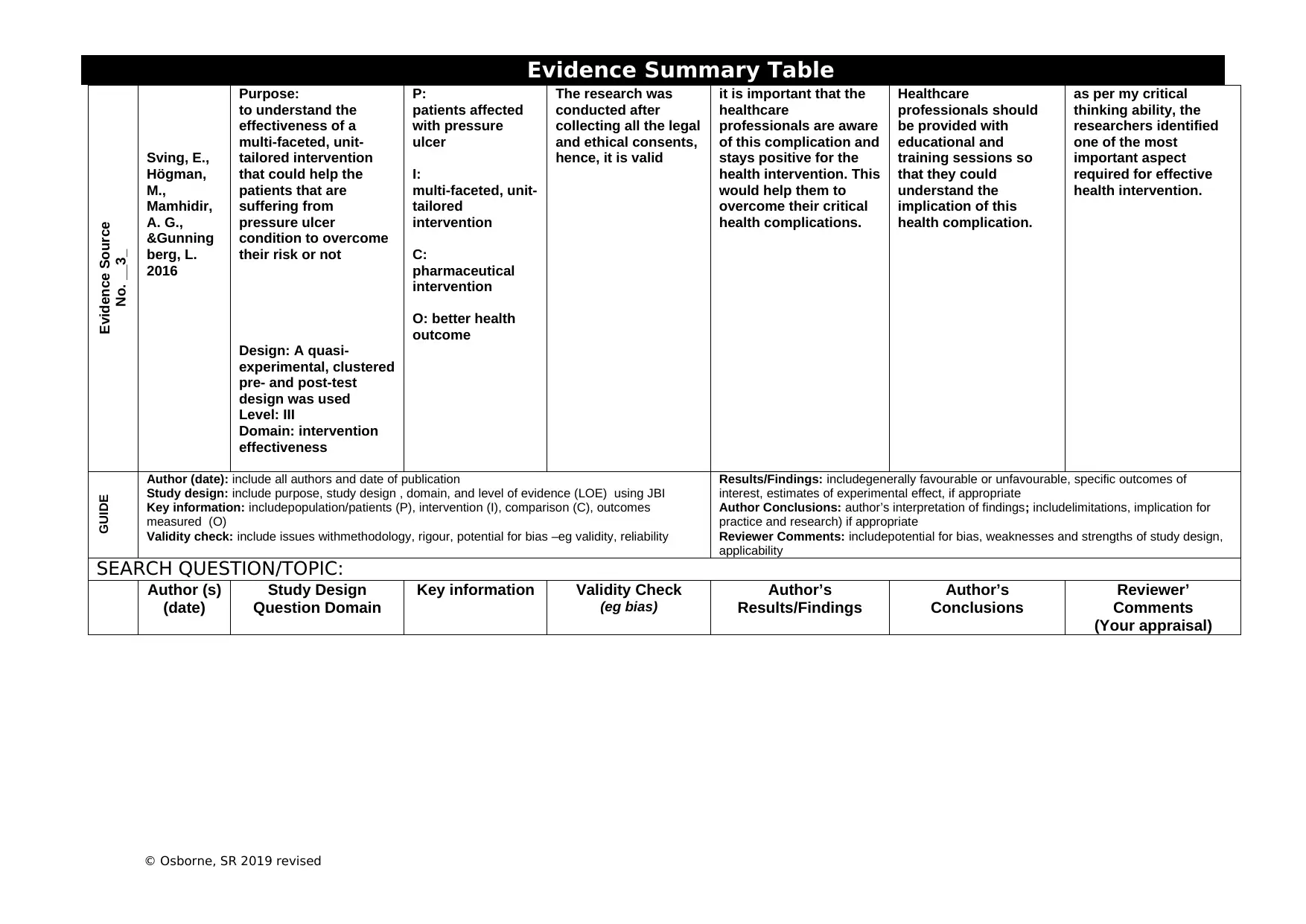
Evidence Summary Table
Evidence Source
No. __3_
Sving, E.,
Högman,
M.,
Mamhidir,
A. G.,
&Gunning
berg, L.
2016
Purpose:
to understand the
effectiveness of a
multi-faceted, unit-
tailored intervention
that could help the
patients that are
suffering from
pressure ulcer
condition to overcome
their risk or not
Design: A quasi-
experimental, clustered
pre- and post-test
design was used
Level: III
Domain: intervention
effectiveness
P:
patients affected
with pressure
ulcer
I:
multi-faceted, unit-
tailored
intervention
C:
pharmaceutical
intervention
O: better health
outcome
The research was
conducted after
collecting all the legal
and ethical consents,
hence, it is valid
it is important that the
healthcare
professionals are aware
of this complication and
stays positive for the
health intervention. This
would help them to
overcome their critical
health complications.
Healthcare
professionals should
be provided with
educational and
training sessions so
that they could
understand the
implication of this
health complication.
as per my critical
thinking ability, the
researchers identified
one of the most
important aspect
required for effective
health intervention.
GUIDE Author (date): include all authors and date of publication
Study design: include purpose, study design , domain, and level of evidence (LOE) using JBI
Key information: includepopulation/patients (P), intervention (I), comparison (C), outcomes
measured (O)
Validity check: include issues withmethodology, rigour, potential for bias –eg validity, reliability
Results/Findings: includegenerally favourable or unfavourable, specific outcomes of
interest, estimates of experimental effect, if appropriate
Author Conclusions: author’s interpretation of findings; includelimitations, implication for
practice and research) if appropriate
Reviewer Comments: includepotential for bias, weaknesses and strengths of study design,
applicability
SEARCH QUESTION/TOPIC:
Author (s)
(date)
Study Design
Question Domain
Key information Validity Check
(eg bias)
Author’s
Results/Findings
Author’s
Conclusions
Reviewer’
Comments
(Your appraisal)
© Osborne, SR 2019 revised
Evidence Source
No. __3_
Sving, E.,
Högman,
M.,
Mamhidir,
A. G.,
&Gunning
berg, L.
2016
Purpose:
to understand the
effectiveness of a
multi-faceted, unit-
tailored intervention
that could help the
patients that are
suffering from
pressure ulcer
condition to overcome
their risk or not
Design: A quasi-
experimental, clustered
pre- and post-test
design was used
Level: III
Domain: intervention
effectiveness
P:
patients affected
with pressure
ulcer
I:
multi-faceted, unit-
tailored
intervention
C:
pharmaceutical
intervention
O: better health
outcome
The research was
conducted after
collecting all the legal
and ethical consents,
hence, it is valid
it is important that the
healthcare
professionals are aware
of this complication and
stays positive for the
health intervention. This
would help them to
overcome their critical
health complications.
Healthcare
professionals should
be provided with
educational and
training sessions so
that they could
understand the
implication of this
health complication.
as per my critical
thinking ability, the
researchers identified
one of the most
important aspect
required for effective
health intervention.
GUIDE Author (date): include all authors and date of publication
Study design: include purpose, study design , domain, and level of evidence (LOE) using JBI
Key information: includepopulation/patients (P), intervention (I), comparison (C), outcomes
measured (O)
Validity check: include issues withmethodology, rigour, potential for bias –eg validity, reliability
Results/Findings: includegenerally favourable or unfavourable, specific outcomes of
interest, estimates of experimental effect, if appropriate
Author Conclusions: author’s interpretation of findings; includelimitations, implication for
practice and research) if appropriate
Reviewer Comments: includepotential for bias, weaknesses and strengths of study design,
applicability
SEARCH QUESTION/TOPIC:
Author (s)
(date)
Study Design
Question Domain
Key information Validity Check
(eg bias)
Author’s
Results/Findings
Author’s
Conclusions
Reviewer’
Comments
(Your appraisal)
© Osborne, SR 2019 revised
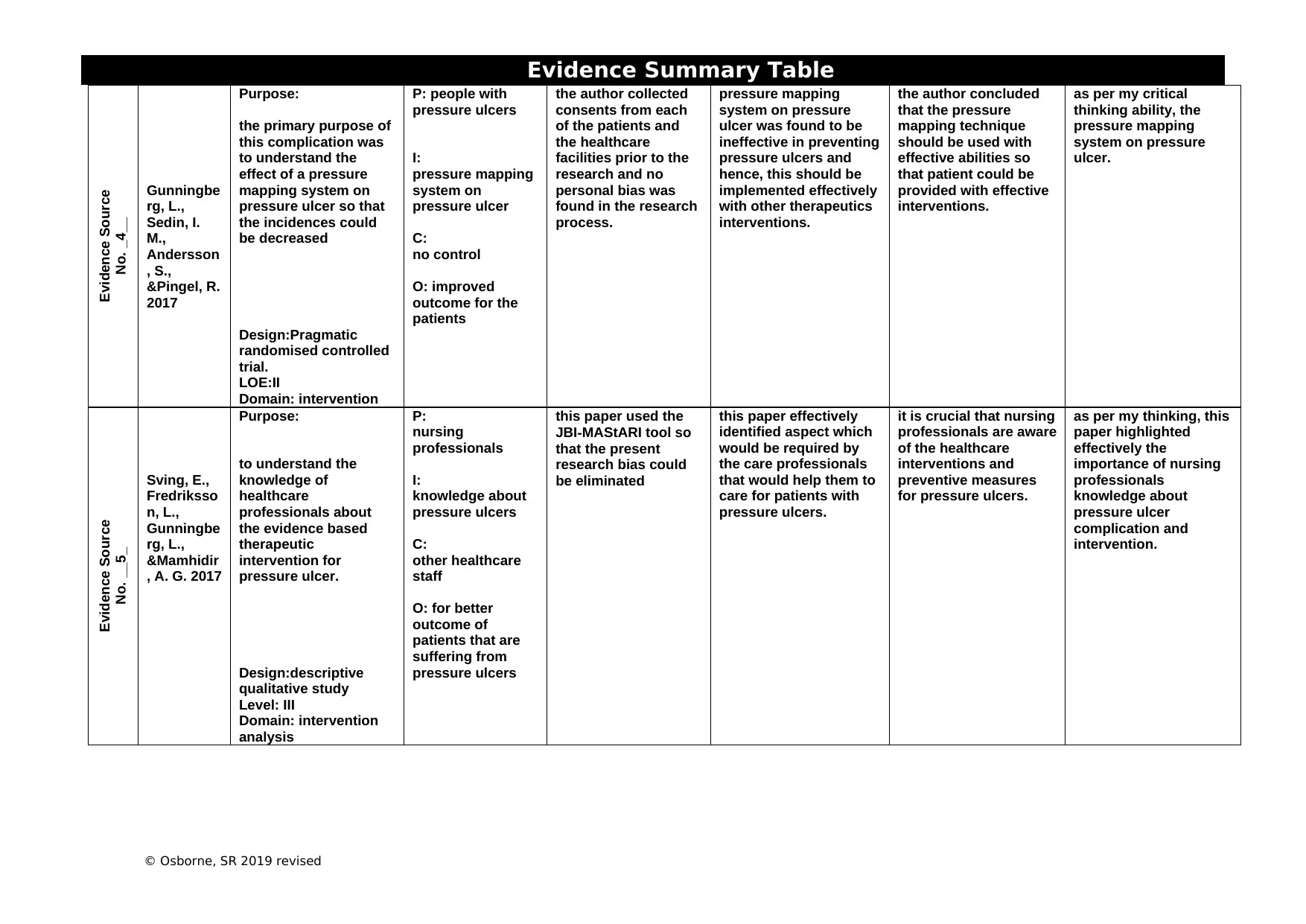
Evidence Summary Table
Evidence Source
No. _4__
Gunningbe
rg, L.,
Sedin, I.
M.,
Andersson
, S.,
&Pingel, R.
2017
Purpose:
the primary purpose of
this complication was
to understand the
effect of a pressure
mapping system on
pressure ulcer so that
the incidences could
be decreased
Design:Pragmatic
randomised controlled
trial.
LOE:II
Domain: intervention
P: people with
pressure ulcers
I:
pressure mapping
system on
pressure ulcer
C:
no control
O: improved
outcome for the
patients
the author collected
consents from each
of the patients and
the healthcare
facilities prior to the
research and no
personal bias was
found in the research
process.
pressure mapping
system on pressure
ulcer was found to be
ineffective in preventing
pressure ulcers and
hence, this should be
implemented effectively
with other therapeutics
interventions.
the author concluded
that the pressure
mapping technique
should be used with
effective abilities so
that patient could be
provided with effective
interventions.
as per my critical
thinking ability, the
pressure mapping
system on pressure
ulcer.
Evidence Source
No. __5_
Sving, E.,
Fredriksso
n, L.,
Gunningbe
rg, L.,
&Mamhidir
, A. G. 2017
Purpose:
to understand the
knowledge of
healthcare
professionals about
the evidence based
therapeutic
intervention for
pressure ulcer.
Design:descriptive
qualitative study
Level: III
Domain: intervention
analysis
P:
nursing
professionals
I:
knowledge about
pressure ulcers
C:
other healthcare
staff
O: for better
outcome of
patients that are
suffering from
pressure ulcers
this paper used the
JBI‐MAStARI tool so
that the present
research bias could
be eliminated
this paper effectively
identified aspect which
would be required by
the care professionals
that would help them to
care for patients with
pressure ulcers.
it is crucial that nursing
professionals are aware
of the healthcare
interventions and
preventive measures
for pressure ulcers.
as per my thinking, this
paper highlighted
effectively the
importance of nursing
professionals
knowledge about
pressure ulcer
complication and
intervention.
© Osborne, SR 2019 revised
Evidence Source
No. _4__
Gunningbe
rg, L.,
Sedin, I.
M.,
Andersson
, S.,
&Pingel, R.
2017
Purpose:
the primary purpose of
this complication was
to understand the
effect of a pressure
mapping system on
pressure ulcer so that
the incidences could
be decreased
Design:Pragmatic
randomised controlled
trial.
LOE:II
Domain: intervention
P: people with
pressure ulcers
I:
pressure mapping
system on
pressure ulcer
C:
no control
O: improved
outcome for the
patients
the author collected
consents from each
of the patients and
the healthcare
facilities prior to the
research and no
personal bias was
found in the research
process.
pressure mapping
system on pressure
ulcer was found to be
ineffective in preventing
pressure ulcers and
hence, this should be
implemented effectively
with other therapeutics
interventions.
the author concluded
that the pressure
mapping technique
should be used with
effective abilities so
that patient could be
provided with effective
interventions.
as per my critical
thinking ability, the
pressure mapping
system on pressure
ulcer.
Evidence Source
No. __5_
Sving, E.,
Fredriksso
n, L.,
Gunningbe
rg, L.,
&Mamhidir
, A. G. 2017
Purpose:
to understand the
knowledge of
healthcare
professionals about
the evidence based
therapeutic
intervention for
pressure ulcer.
Design:descriptive
qualitative study
Level: III
Domain: intervention
analysis
P:
nursing
professionals
I:
knowledge about
pressure ulcers
C:
other healthcare
staff
O: for better
outcome of
patients that are
suffering from
pressure ulcers
this paper used the
JBI‐MAStARI tool so
that the present
research bias could
be eliminated
this paper effectively
identified aspect which
would be required by
the care professionals
that would help them to
care for patients with
pressure ulcers.
it is crucial that nursing
professionals are aware
of the healthcare
interventions and
preventive measures
for pressure ulcers.
as per my thinking, this
paper highlighted
effectively the
importance of nursing
professionals
knowledge about
pressure ulcer
complication and
intervention.
© Osborne, SR 2019 revised
Secure Best Marks with AI Grader
Need help grading? Try our AI Grader for instant feedback on your assignments.
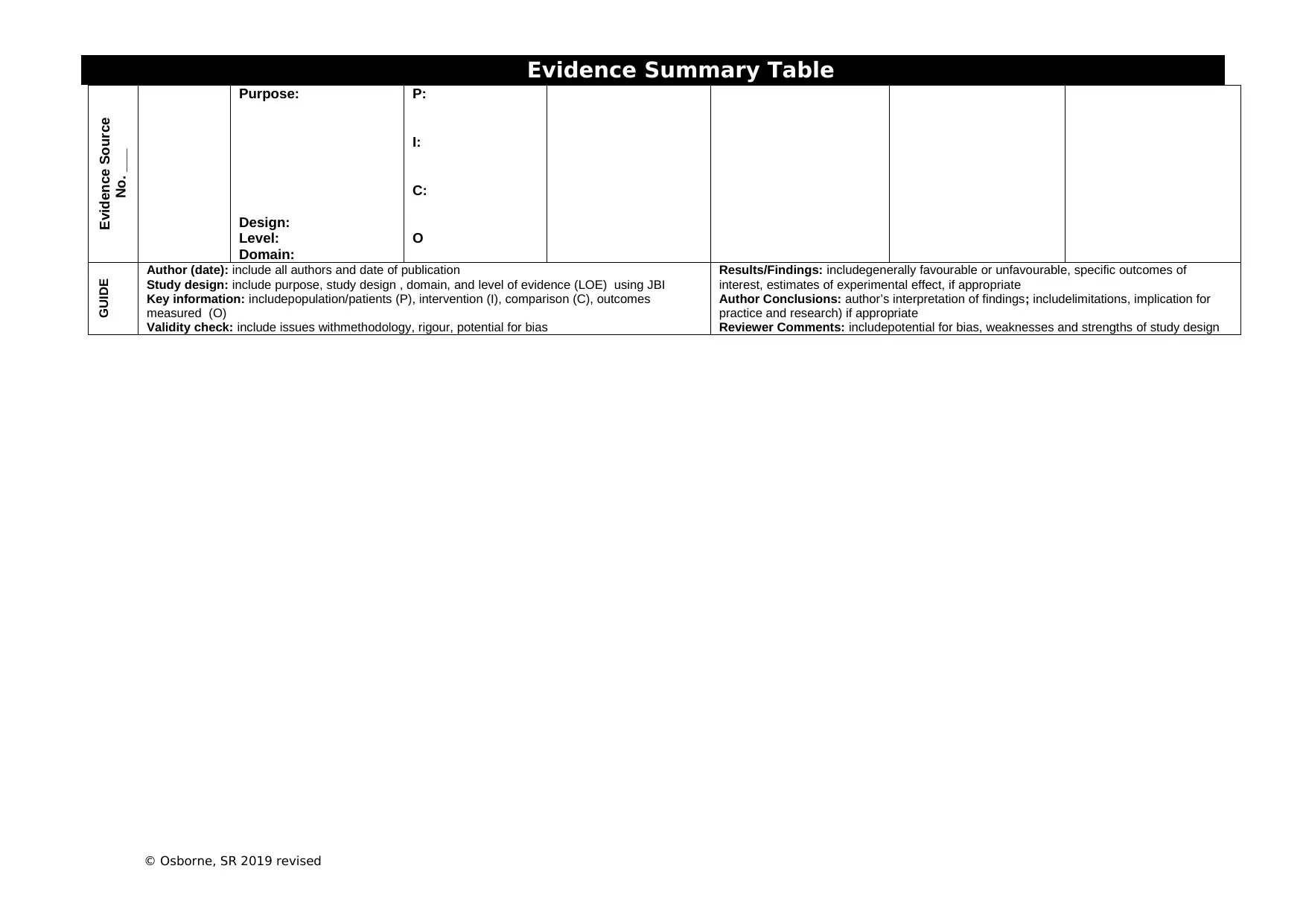
Evidence Summary Table
Evidence Source
No. ___
Purpose:
Design:
Level:
Domain:
P:
I:
C:
O
GUIDE Author (date): include all authors and date of publication
Study design: include purpose, study design , domain, and level of evidence (LOE) using JBI
Key information: includepopulation/patients (P), intervention (I), comparison (C), outcomes
measured (O)
Validity check: include issues withmethodology, rigour, potential for bias
Results/Findings: includegenerally favourable or unfavourable, specific outcomes of
interest, estimates of experimental effect, if appropriate
Author Conclusions: author’s interpretation of findings; includelimitations, implication for
practice and research) if appropriate
Reviewer Comments: includepotential for bias, weaknesses and strengths of study design
© Osborne, SR 2019 revised
Evidence Source
No. ___
Purpose:
Design:
Level:
Domain:
P:
I:
C:
O
GUIDE Author (date): include all authors and date of publication
Study design: include purpose, study design , domain, and level of evidence (LOE) using JBI
Key information: includepopulation/patients (P), intervention (I), comparison (C), outcomes
measured (O)
Validity check: include issues withmethodology, rigour, potential for bias
Results/Findings: includegenerally favourable or unfavourable, specific outcomes of
interest, estimates of experimental effect, if appropriate
Author Conclusions: author’s interpretation of findings; includelimitations, implication for
practice and research) if appropriate
Reviewer Comments: includepotential for bias, weaknesses and strengths of study design
© Osborne, SR 2019 revised
1 out of 17
Your All-in-One AI-Powered Toolkit for Academic Success.
+13062052269
info@desklib.com
Available 24*7 on WhatsApp / Email
![[object Object]](/_next/static/media/star-bottom.7253800d.svg)
Unlock your academic potential
© 2024 | Zucol Services PVT LTD | All rights reserved.





